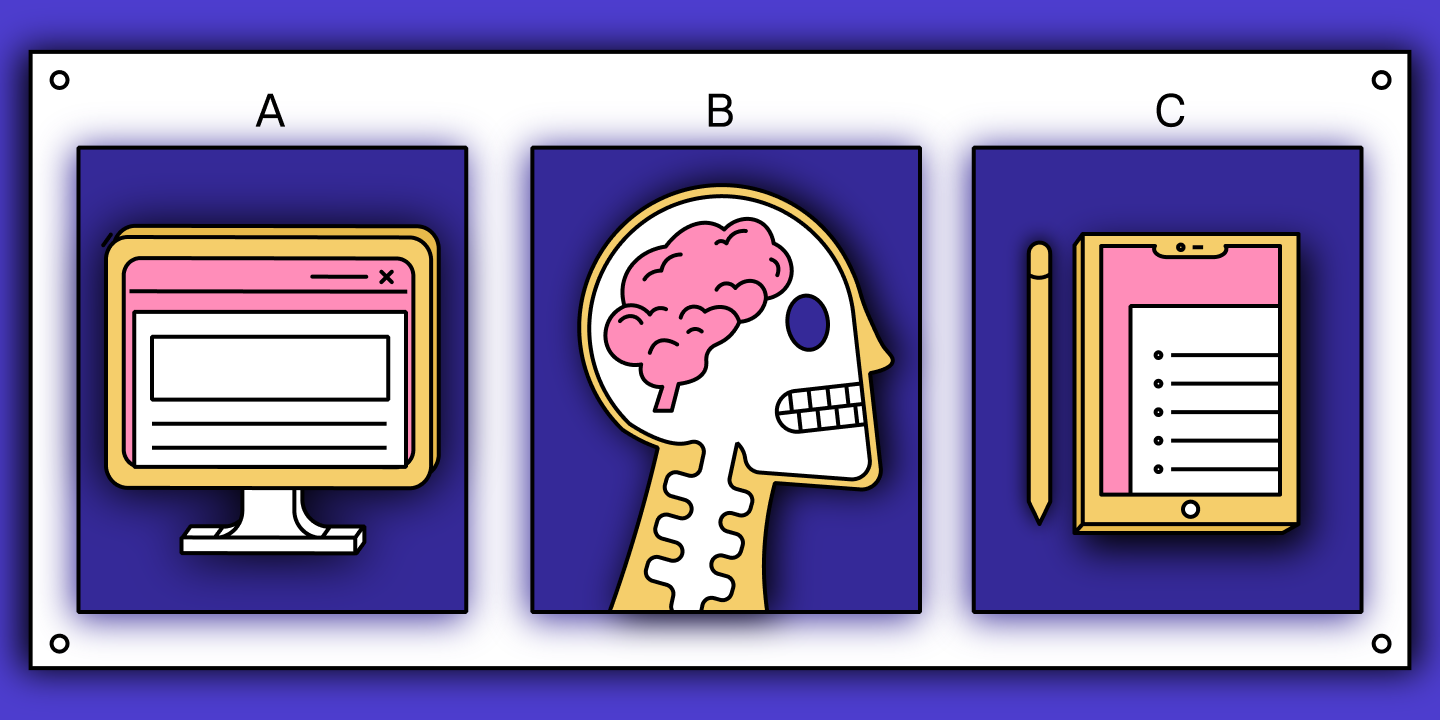A press release can take an ordinary piece of news and amplify it to reach the right people in the right places.
Most press releases follow industry standards and guidelines. If you want journalists, editors, bloggers, and influencers to notice yours, there are certain best practices to follow.
Today, we're going to show you exactly what to include in a press release to get it noticed.
Write a press release with AI
Following the right structure and including all the right elements in your press release can feel like a drag. That’s why we recommend utilizing automated PR tools, such as Prowly, to streamline your press release writing.
With the help of AI, you can create press releases in minutes. Just add the main information and who your target audience is and we'll take care of the rest.
With a tool like Prowly, you can:
- Generate complete press releases automatically using AI
- Utilize press release templates for your own writing
- Receive intelligent recommendations on top recipients for your press releases
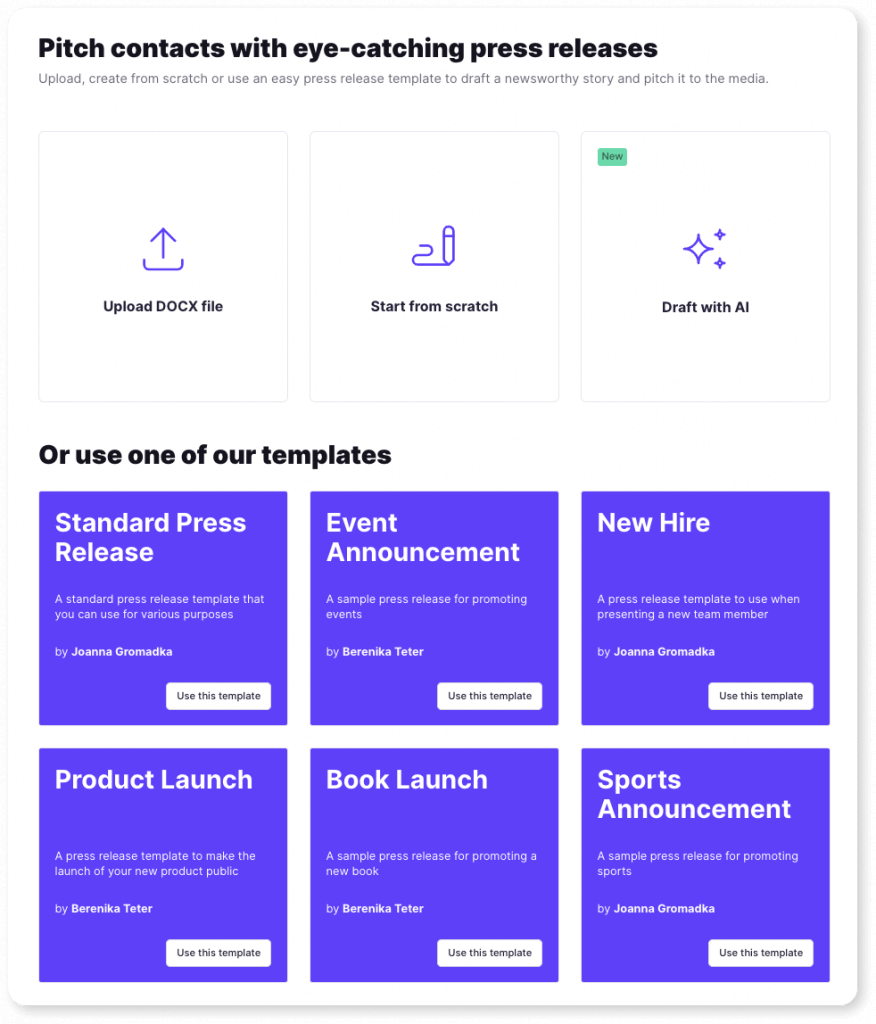
We've put together two guides to help you navigate the AI Press Release Generator for optimal results, as well as for crafting and pitching press releases using AI.
And if you want to gain some inspiration before getting started, use our press release templates! All in one place, you have all the tools you need to get started.
Anatomy of a great press release: key components
Every press release is different, but all good press releases follow a similar format:
- Headline
- Subheader / Lead
- Dateline
- Body
- Quote
- Company info (boilerplate)
- Logo
- Media contact information
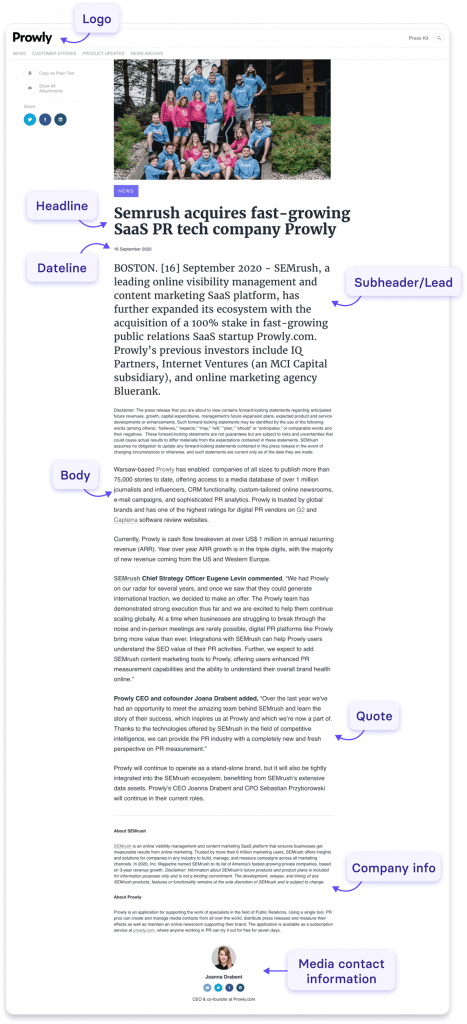
Let's explore each of the elements you need to cover in the anatomy of a press release. Remember, your target journalists receive hundreds of press releases every week and they're used to seeing a certain format. You won't get extra points for creativity - in fact, it can only get your press release ignored.
1. Headline
The headline is arguably the most important part of every press release. The person reading should understand what the press release is about just a few seconds after scanning the headline. Introduce the topic, explain why it's important, and why the reader should care enough to move on to the rest of the press release.
You only have a limited amount of space and characters to work with, so make every letter count.
Here are some tips to create a headline that stands out:
- Focus on the facts and avoid clickbait - you want to gain trust, not lose it
- DO NOT USE ALL CAPS - or your press release will look spammy
- Emphasize the key points of your story and use the 5Ws - who, what, where, when and why
- Try to answer a question with your press release
- Write the headline after finishing the entire press release to make things easier for yourself
- Consider your target audience - you may need to change your headline based on who the reader is
💡Read more on How to Write a Great Press Release Headline (w/ Examples and Tips)
2. Subheadline
Also known as the lead or subheader, this is your spot to expand on the information from your headline. The subheadline is optional, but if you have the time and space to add it, you should. Use it to add more details about the headline and go deeper into the 5Ws.
The same rules remain valid. Do not use this to write clickbait and keep it short and to the point.
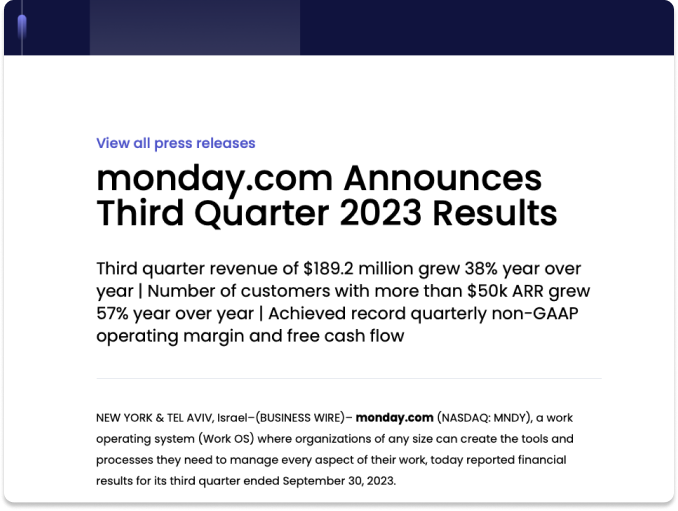
Here is an example of a good subheadline, at the bottom of the image above. It is not a spectacular piece of writing by any means, but it includes additional information that would be too much to put in the headline.
3. Dateline
As the name suggests, it's a line with a date. And it's the place where you include the date and the location of your announcement. Most typically, PR pros include the name of the city in capital letters, while the state and country are optional.

While this may sound outdated, datelines are a standard part of the anatomy of a great press release.
👉Important tips to consider:
- Include the location that the story originated from (i.e. was reported on), rather than the place of the publication.
- There are two main styles for writing datelines - the AP style and the newspaper style. The main difference is that the newspaper style describes when and where the story happened, while the AP style does not have to include the date.
- As counterintuitive as it may sound, the dateline does not need to include a date, but the location is necessary, regardless of which style you use.
4. Introduction
The opening paragraph goes right after the dateline. This is the place where you expand on the 5Ws and explain what happened, where and why the reader should care. Speaking of which, the reader is someone who is a journalist, editor or a writer, and they will appreciate you being factual.
Skip the fancy wordsmithing and just lay out the main details.
5. Body
Most of your press release is going to come from this section. If you're nearing the end of page one, it means that your press release is probably too long. Ideally, no press release should be longer than a single page. And, if this is the case, then you have extra material you can shave off.
To make this section more appealing, try adding extra supporting details to help journalists paint a full picture of what happened. For example, you can include quotes from relevant people or multimedia elements, such as images, videos, presentations, and more.
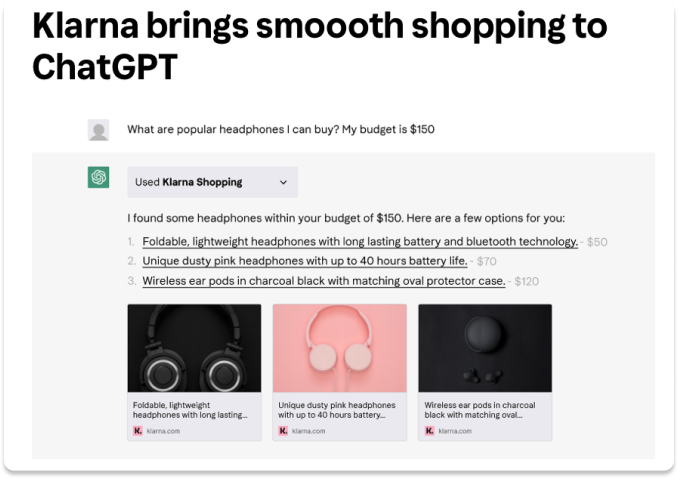
6. Boilerplate
This is another section where you get to talk about yourself, but keep it short and sweet. You want to cover the most important information in the previous sections and this is just the place to remind the reader about who is writing.
Think of it as an "About Us" section on your website, only shorter and more to the point. Include your name, title and relevant awards.
Here is how we do it at Prowly:
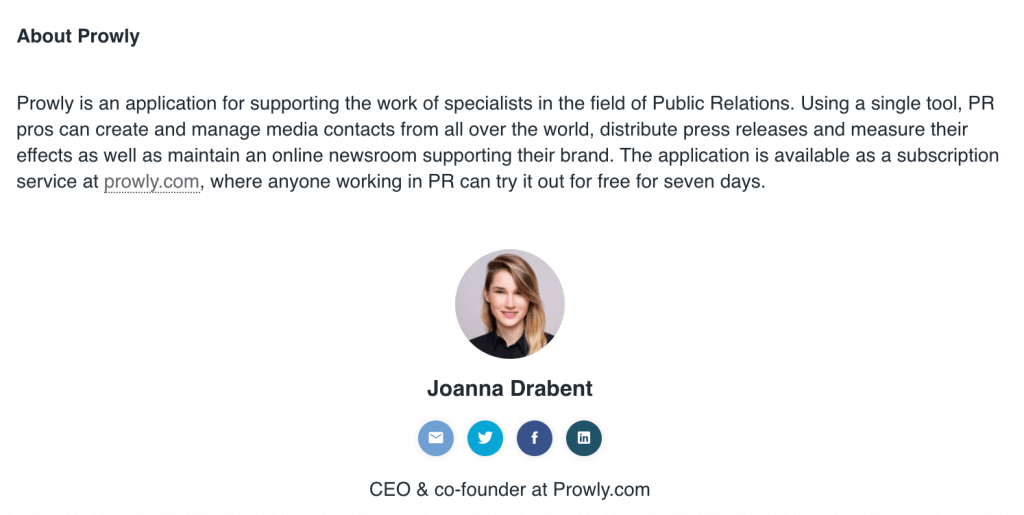
7. Contact Information
If your press release might make someone eager to get in touch with you, make it as easy as possible.
This means two things:
- First, your contact details should be accurate and up-to-date. Check your email, phone number and social handles. If you save these in our free press release template, you'll have them available across all press releases you create in the future.
- The second thing is to provide multiple points of contact. Some journalists prefer email, others like X (Twitter), while some prefer alternative platforms, such as Discord. Give them multiple options. But before doing anything, do your own research to learn where the journalists in your industry spend their time.
Common mistakes to avoid
Whether you're a PR pro or just putting together your first press release, anyone can make a mistake. Here are some of the most common ones to watch out for:
- Neglecting proofreading and editing. Grammar mistakes, typos and inconsistencies make you look sloppy and unreliable as a source. And since your target audience writes for a living, give them something great to work with. With (almost) free tools like Grammarly, there is no excuse.
- Not including multimedia. Launching a new division of your company? Promoting a cool new product? A picture is worth a thousand words. Add images, videos, presentations, anything that can help add more value to your press release. Don't make the journalist dig for information or, god forbid, use something you wouldn't want to share yourself.
- Not tailoring the press release to a specific audience. If your press release is about a new hotel branch you're opening, you don't want to blast the same version to all recipients. For example, an editor of an online magazine and an influencer are going to need different information.
Press release examples and templates
Still not inspired or not ready to start? Here are some great examples you might like:
The Donor Alliance press release
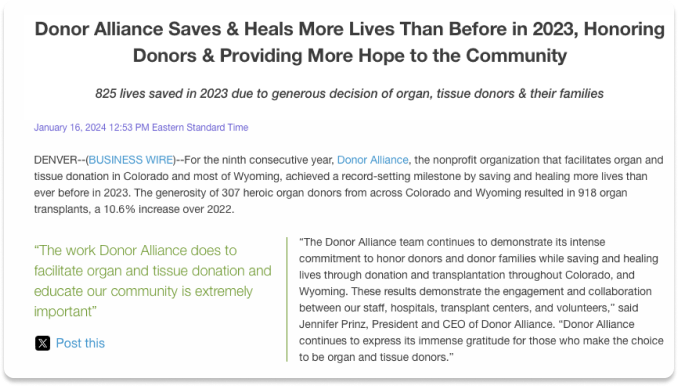
👉Besides being an amazing piece of news, this press release has everything we talked about in this article. There is an expertly written headline and a subheadline, a dateline with the most important information and a captivating intro. To top it all off, there is a quote included to entice journalists to cover this story.
If you're on the hunt for a guide tailored to your line of work, dive into one of these how-to articles. Our PR consultant handpicked them for their spot-on tips and examples. Happy exploring!
- How to Write a Book Press Release (Example and Template)
- How to Write a Music Press Release (Examples & Templates)
- How to Write a Sports Press Release (Example and Template)
- How to Write an Effective Press Release? Journalists Answer
- Writing a New Hire Press Release (with Example and Template)
- How to Write a New CEO Press Release (Examples and Template)
- How to Write an Acquisition Press Release (Example & Template)
- How to Write a Crisis Press Release (Examples and Templates)
- How to Write a Partnership Press Release (Examples & Templates)
- How to Write a Nonprofit Press Release (Example & Template)
- How to Write an Art Exhibition Press Release (Example and Template)
- How to Write a CEO Resignation Press Release (Example and Template)
- How to Write a Rebranding Press Release (Examples and Template)
TaskShift press release
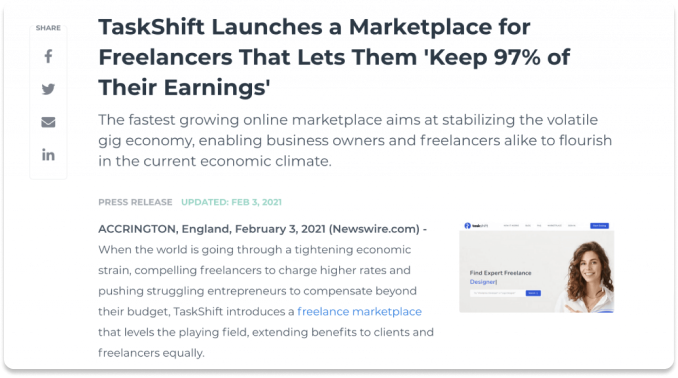
👉As we've pointed out before, killer press releases get straight to the point. Take a look at this fresh one from TaskShift—it's no exception. It spells out the scoop (they're launching a cool new service), throws in the unique selling proposition, and shares the mission and vision. Not much more to say about that, right?
Starting a fresh venture and wondering how to whip up your debut press release for a small business? Well, look no further—check out this step-by-step guide!
Conclusion
The media formats and platforms may keep changing, but the ideal anatomy of a press release has remained the same throughout the years. Don't let this discourage you - it means that with the right tools, anyone can create a stunning press release that gets results.With Prowly, we have the tools to help you get there. Our AI PR Creator along with our templates make easy work of press releases for any industry.
